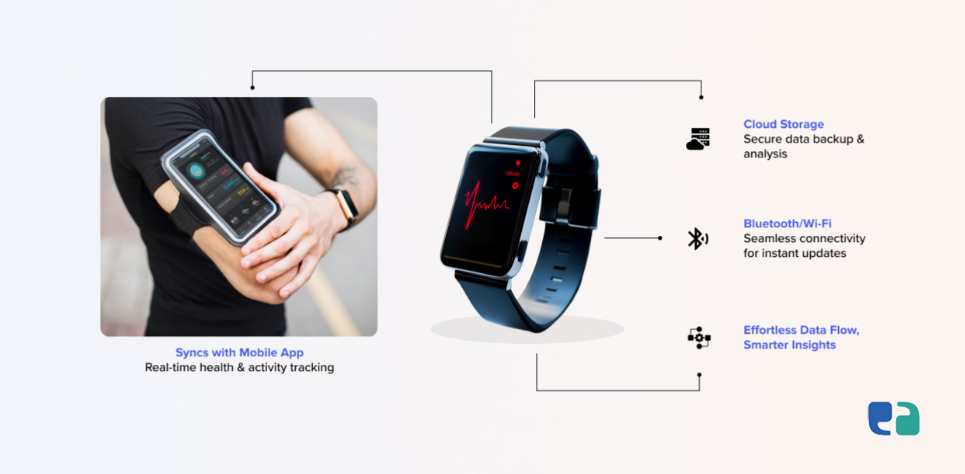Fun fact
The first wearable health tracker wasn’t a fancy smartwatch—it was a simple pedometer from the 1960s called the Manpo-Kei, which literally means “10,000 steps meter” in Japanese.
Fast forward to today, and wearable health tech has exploded.
We’ve got smartwatches tracking heart rate, patches monitoring glucose levels, and even wearables that detect early signs of heart conditions.
And people love them!
The global wearable healthcare devices market is projected to reach nearly $70 billion by 2028, growing at an annual rate of over 11%.
But here’s the thing—tracking data is one thing, making it useful is another.
Doctors don’t have time to sift through endless numbers, and if the data doesn’t fit into their systems, it’s just noise.
That’s where medical wearable data app development comes in.
These apps collect, process, and organize wearable data in a way that actually helps both patients and healthcare providers.
Whether it’s sending real-time alerts, integrating with EHRs, or providing AI-powered health insights, the right app can turn raw numbers into meaningful, life-changing information.

What is Medical Wearable Data App Development?
Medical wearable data app development is all about building apps that connect with wearable health devices.
These apps collect, analyze, and display health data, helping both patients and healthcare providers make better decisions.
How It Works

- Data Collection: Wearable devices, like smartwatches or glucose monitors, track health metrics like heart rate, activity, or glucose levels.
- Data Transmission: The device sends this data to a mobile app via Bluetooth or Wi-Fi.
- Data Analysis: The app processes the data using AI or cloud-based tools to detect patterns or health risks.
- Data Visualization: Users see their health data in easy-to-understand charts, graphs, and alerts.
- Healthcare Integration (Optional): Some apps sync with Electronic Health Records (EHRs) so doctors can access patient data directly.
These devices, paired with smart apps, are transforming healthcare by enabling proactive monitoring, personalized care, and better clinical decisions.

Types of Wearables & Their Uses
Wearable medical devices come in different forms, each designed for specific health monitoring:
1. Smartwatches & Fitness Trackers
Popular among consumers, these devices track:
- Heart Rate: Measures beats per minute and detects anomalies. Some even track heart rate variability (HRV).
- Physical Activity: Counts steps, calories burned, and exercise intensity.
- Sleep Patterns: Monitors sleep stages and quality.
- Fall Detection: Useful for elderly users.
- Respiratory Rate: Some advanced models now track breathing patterns.
- ECG Monitoring: Certain smartwatches like the Apple Watch can perform electrocardiograms and detect irregular heart rhythms.
Example: In 2020, smartwatches with blood oxygen monitoring hit the market. Studies have also shown that these watches can detect abnormal heart rhythms.
2. Continuous Glucose Monitors (CGMs)
Used mainly by diabetes patients, CGMs continuously track glucose levels.
Apps connected to these devices help users manage their blood sugar with real-time alerts and trends.
Fact: Research shows that CGM apps combined with lifestyle guidance can significantly improve metabolic health.
3. Smart Patches
Small, wearable patches that stick to the skin to monitor:
- Heart rate variability
- Glucose levels (using tiny sensors)
- Body temperature
- Drug delivery (some can release medication directly into the skin)
Example: A smart patch can store heart data for up to 11 days, providing continuous monitoring.
4. Wearable Blood Pressure Monitors
These are emerging as convenient tools for continuous blood pressure tracking. Many require FDA clearance for medical use.
5. Smart Clothing & Shoe Sensors
Wearable sensors in fabrics or shoes track posture, gait, and activity. Some can even detect if a person steps off a sidewalk onto a road.
The growing market for medical wearables and the increasing sophistication of these technologies signal a major shift toward data-driven, patient-centric healthcare.
So, how do you build a smart, secure, and user-friendly medical wearable data app? Let’s break it down into three phases.
The Challenge of Building a Medical Wearable Data App
Medical wearable apps have huge potential. But making them work in real healthcare settings? That’s the tough part.
How do you ensure the data is accurate and continuous across multiple devices? How do you keep patient information secure while making it easy to access for providers?
And how do you build an app that actually fits into clinical workflows, rather than just collecting data that no one uses?
These challenges are why many wearable health apps fail.
At SyS Creations, we’ve spent over 10 years solving these problems. Our team knows how to build healthcare-grade solutions that work seamlessly for both patients and providers.
- Flawless Device & EHR Integration – We ensure your app connects with wearables, Apple Health, Google Fit, and EHRs effortlessly.
- Security & Compliance First – HIPAA, PIPEDA, FDA? We make sure your app meets all the necessary regulations.
- AI-Powered Insights – We turn raw biometric data into actionable health insights.
- User-Friendly for Everyone – Intuitive designs that keep patients engaged and make it easy for providers to use.
With a team of 50+ healthcare IT experts, we build medical wearable data apps that aren’t just functional—they make a real impact in healthcare.



